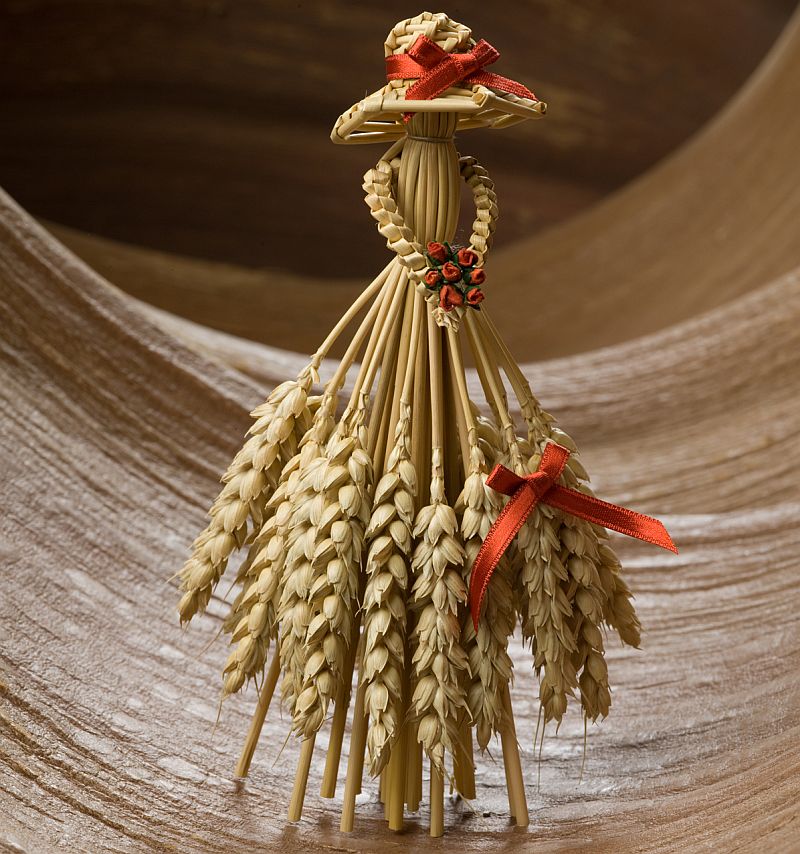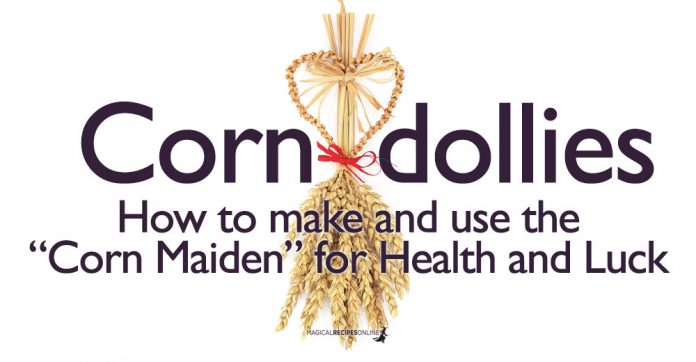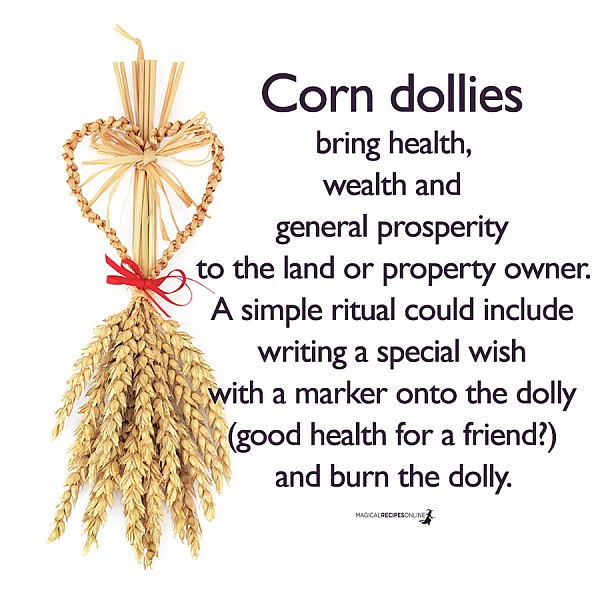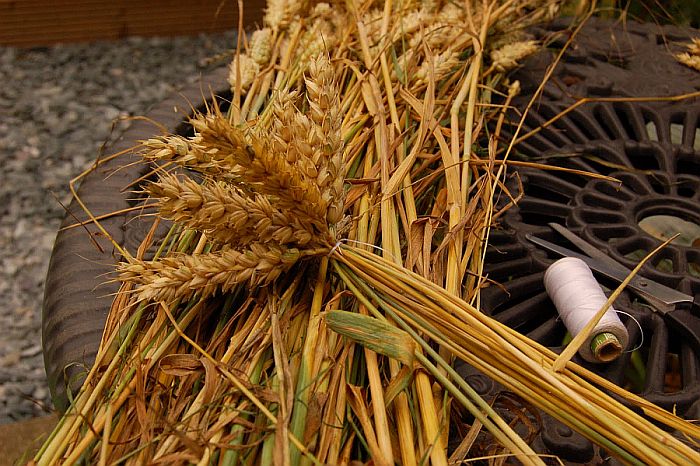How To Make Corn Dollies
- Details
- Written by CrystalWind.ca
- Views: 10960

Corn dollies bring health, wealth and general prosperity to the land or property owner according to old witches. Learn how to make and use corn dollies!
One activity for Lughnasadh that is thousands of years old is the making of the “Corn Dollies”. This is a custom that originates with the people that once grew corn before the invention of farming machinery. They believed that the grain crops were home to a spirit. When they harvested the crop, it would made the spirit homeless. This Spirit was called the “Corn Maiden”, “Corn-Mother” or the “Corn Spirit”.
Corn Dollies were made from the last sheaf of corn that was cut and would be kept until spring to ensure the harvest would be a good one. The Corn Spirit would be made homeless at the harvest, and my creating a “Dolly” from the sheaves, or plaited straw they would be rehomed within and reborn in the following year’s crop.

During Harvest Festivals and Feasts, a Corn Dolly would sit on the table at a place of honour to bless the banquet. The Harvest feast was often held in honour of the farmers, and not only was there a grand meal, but games were often played, music too.
With the advent of the Industrial Revolution and the invention of farming machines, the traditions of creating a Corn Dolly from the last sheaf all but died out, however the custom survives still in the art of crafting things from straw as a hobby.
Traditional Uses
- The last sheaf of the harvest, dressed in a woman's dress or woven into an intricate shape and decked with ribbons, is regarded as the embodiment of the spirit of the crop, the spirit of the growing grain itself. The safe-keeping of this corn dolly over the winter insures fertility for the following harvest, provided that some portion of it is given to cattle and horses to eat, and some portion of it strewn in the field or mixed with the seeds for the next crop.
- This practice of saving the spirit of the harvest is extensive throughout Europe.
- In Northumberland, the corn dolly is attached to a long pole and carried home to be set up in the barn. In some communities it goes home on the lastload. Sometimes it is fairly small. In parts of Germany, the heavier it is, the better.
- On the Isle of Lewis in Scotland, the corn dolly's apron is filled with bread, cheese and a sickle. In other parts of Scotland, the reapers hold races. The man who finishes reaping first designates his last sheaf the corn maiden; the one who finishes last makes his last sheaf into a hag.
- In some localities, the corn dolly is made by the first farmer who finishes his harvest and then passed from farm to farm as each farmer finishes his harvest, ending up with the farmer who finishes last. In this case, no one wants the dolly as it is a sign of procrastination.
- In Wales, others try to snatch the dolly from the reaper who carries it from the field. If he gets home safe, he gets to keep it on his farm for the rest of the year.
- French, Slavonic, and some Germanic regions use the last sheaf to create a Kornwolf, believed to hold a wolf-like spirit that resides in the last sheaf and provides the same life force for the next season. This is a fiercer version of the corn dolly and is sometimes used to scare children.
- Today, corn dollies are seen as emblems of abundance.
Why corn?
- Historically the word corn was applied to the the small hard grain or fruit of a plant. It was used generically to refer to the leading crop of the district. In England, corn was wheat; in Scotland, oats; in the U.S., maize.
Creating a Corn Dolly
Corn dollies bring health, wealth and general prosperity to the land or property owner according to old Witches. A simple ritual could include writing a special wish with a marker onto the dolly (good health for a friend?) and burn the dolly.
Items you will need:
- Corn husks
- Large bowl of water
- Twine or string
- Scissors
- Old pieces of fabric
- Watercolours or markers
- Glue

- Soak the cornhusks in warm water for an hour, until they become pliable.
- Gather several of the damp husks and then tie them together with a piece of twine about ½ inch from one end.
- To make the head, hold the knotted end in one fist, then fold the husks down (as though you were peeling a banana) so that they cover the knotted end.
- Smooth out the husks to make a face, then secure them with a piece of twine around the doll’s neck.
- To make the arms, roll up a single husk and tie it off at both ends. Position the arms up between the husks, under the doll’s neck. Smooth the husks over the arms to form the chest and back then cinch in the waist with twine.
- For a skirt or legs, arrange several husks, inverted (like a skirt that has blown up over the doll’s head) around the waist. Secure with twine, then fold the skirt down. For legs, divide the husks into two parts, tying each bunch at the knees and ankles
- To make clothes, hair, hats or other headpieces, glue on little pieces of fabric. You can use markers and watercolors to give the illusion of facial features.
- You can add Glitter as well as any other decorations to the Corn Husk Doll.
Get into the swing of harvest by trying out this age-old tradition!

![]()
Nixie Vale
Source
Posted on CrystalWind.ca © 2017-2024. All rights reserved. Reproduction of content is prohibited without written permission. The article's title was created by CrystalWind.ca.
Liked this article? Dive deeper into personal growth and wellness! Check out CrystalWind.ca for spiritual wisdom or explore AromaWorx.ca for natural well-being tips. Spread the positivity—share this with friends on their happiness journey!
Let’s Chat! Drop Your Thoughts Below! ![]()
Latest Articles

Imagine a world of inspiration and healing, free for all—made possible by YOU!
Donate Now—Ignite the Magic at CrystalWind.ca!

Epilepsy - Finding A Cure
Your donation can make a difference!
Help us find a cure – donate now!
Unlock Your Light: Join Lightworkers Worldwide on CrystalWind.ca!
Articles: Wiccan Tools of the Craft
Follow Us!
Featured This Month
Crystals for Virgo
As the warmth of summer begins to soften into the crispness of autumn, the Sun... Read more
Virgo Mythology
The Virgo Myth In all of constellation mythology, few legends are as misund... Read more
Mabon in Modern Times: Fresh Takes on the Au…
The Mabon season begins somewhere around the 21st-22nd of September and cont... Read more
Sun in Virgo
An Overview of Sun Sign Characteristics for Virgo Virgo is guided by Mercur... Read more
Sweet Violet
Sweet Violet Faithfulness and modesty. “I will always be true to you.” Helps... Read more
The Vine: September 2nd - September 29th
The Autumnal Equinox ( Alban Elfed ) Celtic Symbol : The White Swan Read more
Peridot: The Healer's Stone
Peridot has been used as a Power Stone for centuries. Peridot fosters emotio... Read more
Watermelon Tourmaline
Synonym: Rainbow Tourmaline The watermelon tourmaline is a rare variety t... Read more
Mabon Magic: Ideas For Fall Decoration And R…
Welcome (almost!) to Fall! We’re turning the Great Wheel once again, toward ... Read more












































